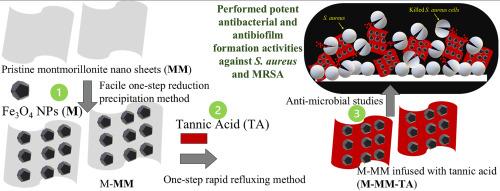Montmorillonite modified with Fe3O4 and tannic acid for inhibition of S. aureus and MRSA biofilm formation
IF 5.8
2区 地球科学
Q2 CHEMISTRY, PHYSICAL
引用次数: 0
Abstract
In this study we introduce a novel nano-biocomposite, M-MM-TA, composed of clay montmorillonite (MM) modified with magnetic (M) Fe3O4 and tannic acid (TA), designed to combat S. aureus, MRSA, and their biofilm. Bacterial attachment and biofilm formation are significant challenges to public health, medicine, and the clinical industry. Staphylococcus aureus (S. aureus), a gram-positive pathogenic bacterium, is known to be the cause of infectious diseases in both humans and animals. Methicillin-resistant Staphylococcus aureus (MRSA), a major cause of healthcare-associated infections, has emerged due to its resistance to antibiotics. Considering MRSA's resistance to antibiotics, it is essential to explore and characterize alternative antibacterial agents. Comprehensive characterization through SEM, SEM-EDS, TEM, TEM-EDS, XPS, XRD and VSM analyses confirmed the successful synthesis of M-MM-TA. To confirm the anti-bacterial effects of nanocomposite, we treated M-MM-TA on S. aureus and MRSA. Then we evaluated the anti-biofilm effect of M-MM-TA by using CV staining and live/dead assay. The results showed that M-MM-TA inhibits biofilm formation against S. aureus and MRSA. Additionally, SEM morphological analysis confirmed that M-MM-TA caused dissociation of the bacteria from biofilms. To confirm the mechanism of anti-biofilm effect, gene expression level was analyzed related to biofilm formation. The results showed that icaA, B, C, D genes are downregulated by the M-MM-TA. Overall, these results demonstrated that M-MM-TA has significant potential as an anti-bacterial agent and inhibits biofilm formation against S. aureus and MRSA. These findings suggest that M-MM-TA can be used in various biomedical applications to inhibit gram-positive bacterial infections.

用Fe3O4和单宁酸修饰蒙脱土抑制金黄色葡萄球菌和MRSA生物膜的形成
在这项研究中,我们介绍了一种新的纳米生物复合材料,M-MM-TA,由磁性(M) Fe3O4和单宁酸(TA)修饰的粘土蒙脱土(MM)组成,旨在对抗金黄色葡萄球菌,MRSA及其生物膜。细菌附着和生物膜的形成是公共卫生、医学和临床行业面临的重大挑战。金黄色葡萄球菌(金黄色葡萄球菌)是一种革兰氏阳性致病菌,已知是人类和动物传染病的原因。耐甲氧西林金黄色葡萄球菌(MRSA)是医疗保健相关感染的主要原因,由于其对抗生素的耐药性而出现。考虑到MRSA对抗生素的耐药性,探索和表征替代抗菌药物是必要的。通过SEM、SEM- eds、TEM、TEM- eds、XPS、XRD、VSM等综合表征证实M-MM-TA合成成功。为了证实纳米复合材料对金黄色葡萄球菌和MRSA的抗菌作用。采用CV染色法和活/死法评价M-MM-TA的抗生物膜作用。结果表明,M-MM-TA能抑制金黄色葡萄球菌和MRSA的生物膜形成。此外,SEM形态分析证实M-MM-TA导致细菌与生物膜分离。为了确定抗生物膜作用的机制,我们分析了与生物膜形成相关的基因表达水平。结果表明,icaA、B、C、D基因被M-MM-TA下调。总的来说,这些结果表明M-MM-TA具有显著的抗菌潜力,可以抑制金黄色葡萄球菌和MRSA的生物膜形成。这些发现表明M-MM-TA可用于各种生物医学应用,以抑制革兰氏阳性细菌感染。
本文章由计算机程序翻译,如有差异,请以英文原文为准。
求助全文
约1分钟内获得全文
求助全文
来源期刊

Applied Clay Science
地学-矿物学
CiteScore
10.30
自引率
10.70%
发文量
289
审稿时长
39 days
期刊介绍:
Applied Clay Science aims to be an international journal attracting high quality scientific papers on clays and clay minerals, including research papers, reviews, and technical notes. The journal covers typical subjects of Fundamental and Applied Clay Science such as:
• Synthesis and purification
• Structural, crystallographic and mineralogical properties of clays and clay minerals
• Thermal properties of clays and clay minerals
• Physico-chemical properties including i) surface and interface properties; ii) thermodynamic properties; iii) mechanical properties
• Interaction with water, with polar and apolar molecules
• Colloidal properties and rheology
• Adsorption, Intercalation, Ionic exchange
• Genesis and deposits of clay minerals
• Geology and geochemistry of clays
• Modification of clays and clay minerals properties by thermal and physical treatments
• Modification by chemical treatments with organic and inorganic molecules(organoclays, pillared clays)
• Modification by biological microorganisms. etc...
 求助内容:
求助内容: 应助结果提醒方式:
应助结果提醒方式:


